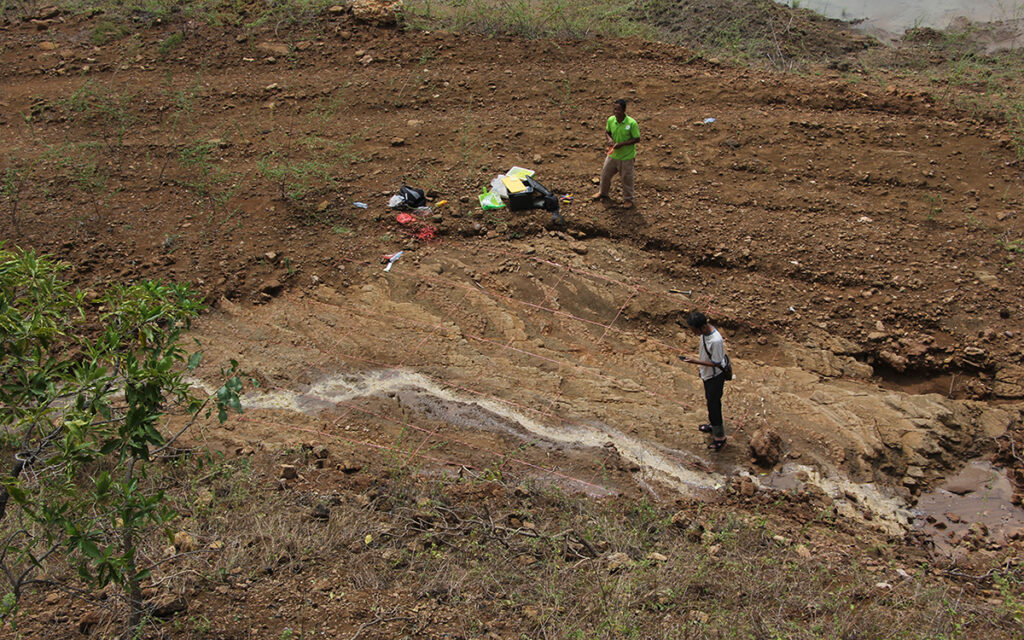តើសត្វទ្រីឡូបាយ Trilobiteជាអ្វី? វាជាប្រភេទសត្វសមុទ្រដែលមានកំណើតមកជាយូរយារណាស់មកហើយ។ Trilobites គឺជាសត្វសមុទ្រសំបូរច្រើន និងមានការលូតលាស់ល្អជាងគេ ក្នុងចំណោមសត្វសមុទ្រដំបូងគេទាំងអស់ ដែលមាននៅក្នុងមហាសមុទ្រជិត ២៧០ លានឆ្នាំ ដោយមានជាង ២២,០០០ ប្រភេទត្រូវបានលើយកបរិយាយ និងសិក្សា។ Trilobite ស្ថិតនៅក្នុងសាខា Arthropoda ក្នុងនោះមានដូចជាពពួក សត្វបាលាំងកាស ក្តាម និងសត្វផ្សេងៗមួយចំនួនទៀត។
តារាងវគ្គីសាស្ត្រ (Taxonomy)
| Kingdom រជ្ជៈ | Phylum សាខា | Class ថ្នាក់ | Order លំដាប់ | Family សណ្តាន | Genes ពួក | Species ប្រភេទ |
| Animal | Arthropoda | Trilobita |
ការរស់នៅនៃពពួក Trilobite មានវត្តមានក្នុងស័ក Paleozoic (២៥២-៥៤២លានឆ្នាំ)សម័យកាល Cambrian (៤៨៥.៤-៥៤២លានឆ្នាំ) មានការរីកចំរើន និងមានពូជកាន់តែច្រើន រហូតមកដល់ចុងសម័យកាល Permian (២៥២-២៩៩ លានឆ្នាំ)។

ការសិក្សាស្រាវជ្រាវនៅកម្ពុជា
សត្វទ្រីឡូបាយ ឃើញមានវត្តមាននៅខាងជើងឈៀងខាងលិច ខេត្តស្ទឹងត្រែង ប្រមាណ១០គីឡូម៉ែត្រ។ តែទីតាំងនេះខ្ញុំក៏មិនទាន់បានរកឃើញនៅឡើយនោះទេ។ តាមរយៈការចុះសិក្សានៅតំបន់ភ្នំបាក់ជាលើកទី៣របស់ក្រុមការងារសិក្សាផូស៊ីលនៃនាយកដ្ឋានតំបន់បេតិភណ្ឌ នៅពីថ្ងៃទី១២ ខែតុលា ឆ្នាំ២០២២។ ការសិក្សានេះក្រុមការងារសិក្សាផ្តោតទៅលើបរិស្ថាន នៃជីវិតសត្វសមុទ្រសម័យបុរាណក្នុងតំបន់បេតិកភណ្ឌធម្មជាតិ ភ្នំបាក់ ស្ថិតក្នុងភូមិសាស្រ្ត សង្កាត់ទឹកថ្លា ក្រុងសិរីសោភ័ណ ខេត្តបន្ទាយមានជ័យ។

ក្នុងការសិក្សានេះ ក្រុមការងារបានបែងចែករៀបចំប្លង់ជាពីរទីតាំងសម្រាប់ធ្វើការសិក្សា ដោយទីតាំងទី១មានទំហំ២៥ម៉ែត្រការ៉េ និងទីតាំងទី២មានទំហំ៣០ម៉ែត្រការ៉េ ដែលមានទីតាំងនៅភាគខាងត្បូងភ្នំនៃជើងភ្នំ។ នៅទីតាំងទី២ យើងបានរកឃើញសំណាកសត្វសមុទ្រម្យ៉ាងហៅថា ទ្រីឡូបាយ Trilobite ដែលជាប្រភេទសត្វដ៏មានវ័យចំណាស់មួយនៅលើពិភពលោក។ ក្នុងនោះយើងបានរកឃើញសំណាកសត្វទ្រីឡូបាយនេះចំនួន២ ដែលមានទំហំ២ស.ម។

សំណាកនេះ យើងឃើញតែផ្នែកកន្ទុយកប់ក្នុងស្រទាប់ថ្មផុយមានខ្សាច់លាយដីល្បាប់។ ដោយឡែកផ្នែកខាងក្បាលអាចមានកប់ក្នុងនោះក៏ថាបាន លុះត្រាមានការសម្អាតយកដី ឬថ្មចេញ។ ជាមួយគ្នានេះយើងក៏បានឃើញពពួកខ្យង ដែលមានរូបរាងប្រហាក់ប្រហែលនឹងខ្យងនាពេលបច្ចុប្បន្ន ពពួកប្រាព្យូពូត ពពួកគ្រីណូអ៊ីត ដែលបានរស់នៅផ្តុំគ្នាផងដែរ។ ការរកឃើញវត្តមានរបស់សត្វទ្រីឡូបាយបានបង្ហាញពីភាពចាស់នៃតំបន់នោះ ដូចជាភ្នំបាក់តាមរយៈផែនទីភូគព្ភសាស្ត្រ បានកំណត់តំបន់ភ្នំបាក់ក្នុងអាយុកាលស័ក Paleozoic (២៥២-៥៤២លានឆ្នាំ) សម័យកាល Permian (២៥២-២៩៩លានឆ្នាំ)។ ចំពោះទីតាំងដែលយើងបានសិក្សានៅទីតាំងទី២ អាចមានអាយុចាស់ជាងសម័យកាល Permian។ នេះគ្រាន់តែជាការសន្និដ្ឋានមួយបណ្តោះអាសន្ន តែប៉ុណ្ណោះ ដោយចាំបាច់ត្រូវសិក្សាលម្អិតអំពីប្រភេទផូស៊ីល សត្វសទ្រីឡូបាយ បន្ថែមទៀត ដោយយកទៅប្រៀបធៀបជាមួយនឹងតារាងនៃការវិវត្តន៍របស់សត្វទ្រីឡូបាយ នោះយើងនឹងអាចដឹងពីអាយុប្រហាក់ប្រហែលរបស់ផូស៊ីលសត្វសទ្រីឡូបាយនេះបាន។


ជារួមការរកគំហើញនេះ គឺអាចបង្ហាញអំពីភាពចំណាស់ នៃវត្តមានសត្វបុរេជីវៈចម្រុះ និងជាភស្តុតាងដ៏សំខាន់មួយសម្រាប់ប្រវត្តិសាស្ត្រធម្មជាតិនៃប្រទេសកម្ពុជា។ ក្រុមការងារនិងបន្តសិក្សាលើសត្វនេះនៅពេលក្រោយជាបន្តទៀត៕
————————–
500-Million-Year-Old Trilobite Fossil Found in Banteay Meanchey
What is a Trilobite? It is a marine species that was born a long time ago. Trilobites are abundant marine animal species and the best-growing among the early marine species existing in the ocean for almost 270 million years ago, with more than 22,000 species being described and studied. Trilobites are found in the Arthropoda Phylum, which includes the horseshoe crab, the Crab, and some other animals.
In addition, Trilobite species were in the Paleozoic (252-542 million years) and the Cambrian period (485.4-542 million years). This species increased until the end of the Permian period (252-299 million years).
Conducting research in Cambodia
The trilobite is found about 10 km northwest of Stung Treng province, but I have not yet found this location. This is the third study on the Phnom Bak area that was conducted by the Fossil Study Team of the Heritage Zone Department on October 12, 2022. The study focused on the environment of ancient marine life at the Phnom Bak natural heritage site located in Sangkat Teuk Thla, Serey Sophorn City, Banteay Meanchey Province.
In this study, the team divided the study area into two sites, the first site is 25 square meters and the second site is 30 square meters, located in the southern part of the mountain base. At the second site, we found a marine animal specimen called the Trilobite which is an older species in the world. There are two of Trilobite specimens have been found within 2 cm in size.
In these specimens, we see only the tail part buried in the rock-stone layer. In particular, the head part may be buried in the rock-stone layer. In addition, we have also seen shell species that look like shells today, Brachiopods and Crinoids that have survived together. The presence of Trilobite species and according to geological maps, the Phnom Pak area is identified as in the Paleozoic era (252-542 million years) and the Permian era (252-299 million years). Thus, the second site found Trilobite specimens may be older than the Permian era. This is only a temporary conclusion, with the need to further study in detail species of Trilobite fossils that compare with the evolutionary table of the Trilobite, so we will be able to know the approximate age of this Trilobite fossil.
Overall, this discovery could indicate the age of the presence of marine biodiversity and is an important evidence for the natural history of Cambodia.
អត្ថបទដោយ៖ លោក លឹម វណ្ណច័ន្ទ






